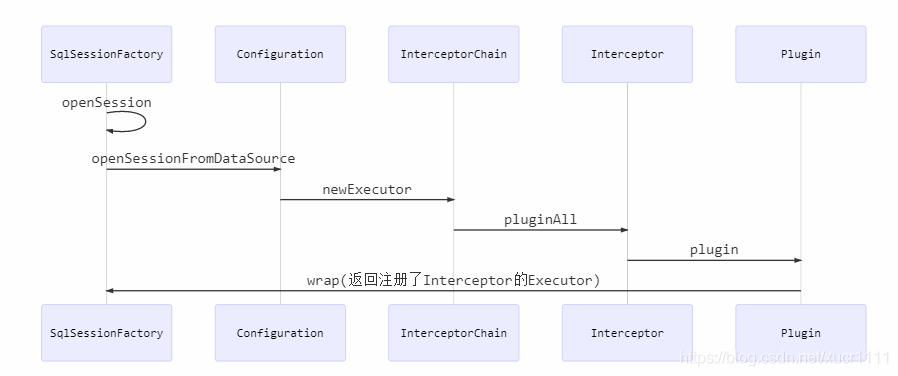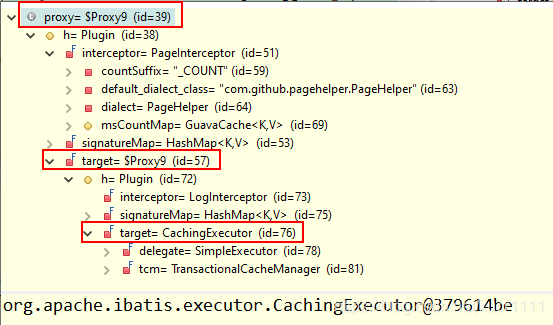插件的配置与使用
在mybatis-config.xml配置文件中配置plugin结点,比如配置一个自定义的日志插件LogInterceptor和一个开源的分页插件PageInterceptor:
<plugins>
<plugin interceptor="com.crx.plugindemo.LogInterceptor"></plugin>
<plugin interceptor="com.github.pagehelper.PageInterceptor">
<property name="helperDialect" value="oracle" />
</plugin>
</plugins>
插件的工作原理
借助责任链模式,定义一系列的过滤器,在查询等方法执行时进行过滤,从而达到控制参数、调整查询语句和控制查询结果等作用。下面从插件的加载(初始化)、注册和调用这三个方面阐述插件的工作原理。
过滤器的加载(初始化)
和其他配置信息一样,过滤器的加载也会在myBatis读取配置文件创建Configuration对象时进行,相应的信息存储在Configuration的interceptorChain属性中,InterceptorChain封装了一个包含Interceptor的list:
private final List<Interceptor> interceptors = new ArrayList<>();
在XMLConfigBuilder进行解析配置文件时执行pluginElement方法,生成过滤器实例,并添加到上述list中:
private void pluginElement(XNode parent) throws Exception {
if (parent != null) {
for (XNode child : parent.getChildren()) {
String interceptor = child.getStringAttribute("interceptor");
Properties properties = child.getChildrenAsProperties();
Interceptor interceptorInstance = (Interceptor) resolveClass(interceptor).getDeclaredConstructor()
.newInstance();
interceptorInstance.setProperties(properties);
configuration.addInterceptor(interceptorInstance);
}
}
}
过滤器的注册
可以为Executor、ParameterHandler、ResultSetHandler和StatementHandler四个接口注册过滤器,注册的时机也就是这四种接口的实现类的对象的生成时机,比如Executor的过滤器的注册发生在SqlSessionFactory使用openSession方法构建SqlSession的过程中(因为SqlSession依赖一个Executor实例),ParameterHandler和StatementHandler的过滤器发生在doQuery等sql执行方法执行时注册,而ResultHandler的过滤器的注册则发生在查询结果返回给客户端的过程中。以Executor的过滤器的注册为例,经过了这样的过程:

现在详细的分析一下Plugin的wrap这个静态的包装方法:
public static Object wrap(Object target, Interceptor interceptor) {
// 从定义的Interceptor实现类上的注解读取需要拦截的类、方法
Map<Class<?>, Set<Method>> signatureMap = getSignatureMap(interceptor);
// Executor、ParameterHandler、ResultSetHandler、StatementHandler
Class<?> type = target.getClass();
// 从当前执行的目标类中进行匹配,过滤出符合当前目标的的过滤器
Class<?>[] interfaces = getAllInterfaces(type, signatureMap);
if (interfaces.length > 0) {
// 动态代理生成Executor的代理实例
return Proxy.newProxyInstance(type.getClassLoader(), interfaces,
new Plugin(target, interceptor, signatureMap));
}
return target;
}
上述代码中的getSignatureMap方法是解析Interceptor上面的注解的过程,从注解中读取出需要拦截的方法,依据@Signature的三个变量类、方法method和参数args就能通过反射唯一的定位一个需要拦截的方法。
private static Map<Class<?>, Set<Method>> getSignatureMap(Interceptor interceptor) {
Intercepts interceptsAnnotation = interceptor.getClass().getAnnotation(Intercepts.class);
if (interceptsAnnotation == null) {
throw new PluginException(
"No @Intercepts annotation was found in interceptor " + interceptor.getClass().getName());
}
Signature[] sigs = interceptsAnnotation.value();
Map<Class<?>, Set<Method>> signatureMap = new HashMap<>();
for (Signature sig : sigs) {
Set<Method> methods = signatureMap.computeIfAbsent(sig.type(), k -> new HashSet<>());
try {
Method method = sig.type().getMethod(sig.method(), sig.args());
methods.add(method);
} catch (NoSuchMethodException e) {
throw new PluginException(
"Could not find method on " + sig.type() + " named " + sig.method() + ". Cause: " + e, e);
}
}
return signatureMap;
}
而getAllInterfaces方法是依据不同的目标对象(Executor等四种)进行过滤的过程,只给对应的目标进行注册:
private static Class<?>[] getAllInterfaces(Class<?> type, Map<Class<?>, Set<Method>> signatureMap) {
Set<Class<?>> interfaces = new HashSet<>();
while (type != null) {
for (Class<?> c : type.getInterfaces()) {
if (signatureMap.containsKey(c)) {
interfaces.add(c);
}
}
type = type.getSuperclass();
}
return interfaces.toArray(new Class<?>[interfaces.size()]);
}
至此,实际使用的Executor对象将是通过动态代理生成的Plugin实例。
过滤器的调用
在第二步中完成了过滤器的注册,在实际调用Executor时,将由实现了InvocationHandler接口的Plugin实例进行接管,对Executor相应方法方法的调用,将实际上调用动态代理体系下的invoke方法:
public Object invoke(Object proxy, Method method, Object[] args) throws Throwable {
try {
Set<Method> methods = signatureMap.get(method.getDeclaringClass());
if (methods != null && methods.contains(method)) {
Object result=interceptor.intercept(new Invocation(target, method, args));
return result;
}
return method.invoke(target, args);
} catch (Exception e) {
throw ExceptionUtil.unwrapThrowable(e);
}
}
如前所述,插件的工作原理是基于责任链模式,可以注册多个过滤器,层层包装,最终由内而外形成了一个近似装饰器模式的责任链,最里面的基本实现是CachingExecutor:

从InterceptorChain的pluginAll方法可以看出这个结构的构造过程:
public Object pluginAll(Object target) {
for (Interceptor interceptor : interceptors) {
// 从这可以看出过滤器的传递的过程:动态代理实例由内而外层层包装,类似于与装饰器的结构,基础 实现是一个Executor
target = interceptor.plugin(target);
}
return target;
}
这种由内而外的包装的栈结构从外向内层层代理调用,完成了责任链任务的逐级推送。从这个注册过程可以看到,在list中越前面的Interceptor越先被代理,在栈结构中越处于底层,执行的顺序越靠后。造成了注册顺序和执行顺序相反的现象。
插件的典型案例:PageHelper
pagehelper是一个实现物理分页效果的开源插件,并且在底层通过Dialect类适配了不同的数据库,其主要作用是拦截sql查询,构造一个查询总数的新的以"_COUNT"结尾的新sql,最终再进行分页查询。
自定义插件
定义Interceptor接口的实现类并在其上使用@Intercepts和@Signature注解进行过滤的类和方法,比如定义一个打日志的插件:
@Intercepts({
@Signature(type = Executor.class, method = "query", args = { MappedStatement.class, Object.class,
RowBounds.class, ResultHandler.class }),
@Signature(type = Executor.class, method = "query", args = { MappedStatement.class, Object.class,
RowBounds.class, ResultHandler.class, CacheKey.class, BoundSql.class }), })
public class LogInterceptor implements Interceptor {
@Override
public Object intercept(Invocation invocation) throws Throwable {
System.out.println("进入了自定义的插件过滤器!");
System.out.println("执行的目标是:" + invocation.getTarget());
System.out.println("执行的方法是:" + invocation.getMethod());
System.out.println("执行的参数是:" + invocation.getArgs());
return invocation.proceed();
}
}
@Intercepts注解中包含了一个方法签名数组,即@Signature数组,@Signature有三个属性,type、method和args分别定义要拦截的类、方法名和参数,这样就可以通过反射唯一的确定了要拦截的方法。type即为在工作原理分析中提到的Executor、ParameterHandler、ResultSetHandler和StatementHandler,method配置对应接口中的方法。